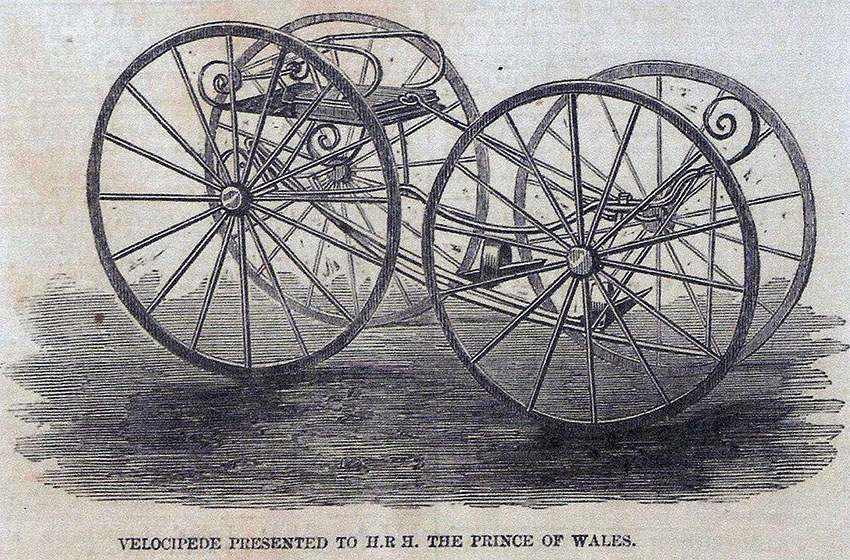

A fact often overlooked in the history of the human-powered transportation is that tricycle design predated that of the bicycle. The ‘Treadle & Tiller’ tricycle was the first successful machine, manufactured from the early 1850s onwards. ‘Self Locomotive’ quadricycles were made too, notably by Willard Sawyer of Dover.
Though she did not ride tricycles herself – they were ridden ‘by proxy’ by a Mrs Roach – the biggest boost to the popularity of tricycles occurred when Queen Victoria purchased a Royal Salvo Tricycle made by James Starley in 1881.
Edward, Prince of Wales, had previously received a quadricycle from Willard Sawyer in 1858 (below).


Late 1870s/ Early 1880s Tiller & Treadle Adult Velocipede Tricycle
Transitional Version with Wood-Spoked Wooden Wheels & Chain Drive
14″ Front Wheel
32″ Rear Wheels
(Now sold)

This very rare late 1870s/ early 1880s treadle-powered adult tricycle has 32″ rear wheels and a 14″ front wheel, and is just under 6′ long.
The first bicycles – velocipedes – of 1869/1870 used wood-spoke wooden wheels with iron-strapped tyres, a technology taken from horse-drawn carriages. But being powered by a pedal in a large front wheel, velocipedes were traditionally ridden by athletic young men …definitely not a suitable means of transportation for a lady. With the strict conventions of the day, a lady required a vehicle motivated with the minimum of physical effort.
Treadle powered tricycles preceded the velocipede, having been invented around 1851. Though the wheels on this machine are of the earliest style of tricycle design, this example can be described as a ‘transitional’ as it uniquely features chain and sprockets, innovations taken from James Starley’s experiments at the end of the 1870s. Compare the treadle and the chain and sprocket layout to Starley’s Salvo.
In 1876, James Starley developed the Coventry Lever Tricycle, with two small wheels on the right side and a large drive wheel on the left side. And, in 1877, he introduced the Coventry Rotary, one of the first rotary chain drive tricycles. Starley’s inventions started a tricycling craze in Great Britain. During 1877-78 there were applications for 57 patents concerning tricycles of the ‘velocipede class’ (as it then was). By 1879, there were ‘twenty types of tricycles and multi-wheel cycles … produced in Coventry, England, and by 1884, there were over 120 different models produced by 20 manufacturers.’ The first front steering tricycle was manufactured in 1881 by The Leicester Safety Tricycle Co, and sold for £18.
By the early 1880s, treadle tricycles had become popular for children. But the latest style of adult tricycle – with rack and pinion steering and a differential – caught on very fast. Within just a few years after their introduction, they made adult tiller & treadle tricycles obsolete. While children continued to use juvenile tiller & treadle tricycles handed down through their families, there was no similar reason to preserve adult versions. As a result, they are very rare today.
Apart from chips and scratches to the paint, this Victorian adult tricycle is in very good condition, having been restored many years ago and stored since in a private collection. It is complete and ready to ride.


VELOCIPEDE TRICYCLE HISTORY: BICYCLE v TRICYCLE

SCIENCE MUSEUM TREADLE TRICYCLE
The first velocipede tricycles with driving treadles and tiller steering appear to have been made around 1851. (See the one above at the Science Museum in London). Only one rear wheel was driven, with the other having a brass-bushed hub revolving freely on the driving axle. The wheels were wooden with iron tyres. The one illustrated above has a 24″ front wheel and 35″ rear wheels.
After the invention of the front-wheel driven Velocipede captured the public imagination in 1869, the cycle industry was created. Design evolved and, by 1880, the Ordinary (‘penny farthing’) and the high wheel tricycle ruled the roads.
Treadle-controlled velocipede tricycles for adults were popular until tricycles with rack and pinion steering and pedals took over. However, treadle & tiller tricycles continued to be made for children, initially being expensive items for well-to-do families. Early examples used wooden hubs and parts but, by the 1880s, they were made of steel, with cast iron fittings. Early models also had metal wheel rims that did not take a tyre, while later ones were fitted with solid rubber tyres.
 Until the advent of the safety bicycle – the first successful ‘rear-driver’ with central pedals was the Premier crossframe in 1886 – women drove tricycles while men rode, first, ‘boneshaker’ velocipedes (above) followed by ordinaries, below. This was a reflection of both the athletic prowess required to ride early bicycles and also conservative dress code of the day: tricycles allowed women to ride with modesty.
Until the advent of the safety bicycle – the first successful ‘rear-driver’ with central pedals was the Premier crossframe in 1886 – women drove tricycles while men rode, first, ‘boneshaker’ velocipedes (above) followed by ordinaries, below. This was a reflection of both the athletic prowess required to ride early bicycles and also conservative dress code of the day: tricycles allowed women to ride with modesty. 










 Willard Sawyer of Dover info with thanks to – http://doverhistorian.com/2013/08/16/willard-sawyer-founder-of-the-worlds-first-factory-for-mass-producing-cycles/
Willard Sawyer of Dover info with thanks to – http://doverhistorian.com/2013/08/16/willard-sawyer-founder-of-the-worlds-first-factory-for-mass-producing-cycles/

















